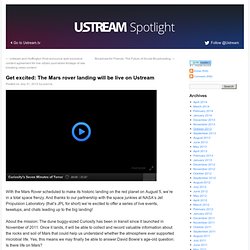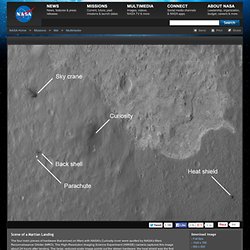

Mars Science Laboratory. Overview[edit] Hubble view of Mars: Gale crater can be seen.

Slightly left and south of center, it's a small dark spot with dust trailing southward from it. MSL successfully carried out a more accurate landing than previous spacecraft to Mars, aiming for a small target landing ellipse of only 7 by 20 km (4.3 by 12.4 mi),[17] in the Aeolis Palus region of Gale Crater. In the event, MSL achieved a landing only 2.4 kilometres (1.5 mi) from the center of the target.[18] This location is near the mountain Aeolis Mons (a.k.a. "Mount Sharp").[19][20] The rover mission is set to explore for at least 687 Earth days (1 Martian year) over a range of 5 by 20 km (3.1 by 12.4 mi).[21] The Mars Science Laboratory mission is part of NASA's Mars Exploration Program, a long-term effort for the robotic exploration of Mars that is managed by the Jet Propulsion Laboratory of California Institute of Technology.
Previous successful U.S. Goals and objectives[edit] Biological Geological and geochemical Rover[edit] Three Weeks Before Curiosity Rover Lands on Mars. At a news conference today NASA discussed the landing on Mars of the Mars Science Laboratory with the Curiosity Rover which takes place in less than three weeks on Monday, August 6th at 1:31 a.m.
EDT (Sunday at 10:31 p.m. PDT). NASA’s Curiosity Mars Rover. How Curiosity Will Search for Clues to Habitable Past on Mars. Get excited: The Mars rover landing will be live on Ustream. With the Mars Rover scheduled to make its historic landing on the red planet on August 5, we’re in a total space frenzy.

And thanks to our partnership with the space junkies at NASA’s Jet Propulsion Laboratory (that’s JPL for short) we’re excited to offer a series of live events, tweetups, and chats leading up to the big landing! About the mission: The dune buggy-sized Curiosity has been in transit since it launched in November of 2011. Once it lands, it will be able to collect and record valuable information about the rocks and soil of Mars that could help us understand whether the atmosphere ever supported microbial life.
Yes, this means we may finally be able to answer David Bowie’s age-old question: Is there life on Mars? Be sure to RSVP for these events on the NASA JPL channel here: Full schedule of live events below: Curiosity Cam, Ustream.TV: UPCOMING EVENTS: Sunday, Aug. 5 NASA Mars Rover Update 9:30 to 10:30 a.m. PDT NASA Science News Conference Mars Science Labor. Scene of a Martian Landing. Scene of a Martian Landing The four main pieces of hardware that arrived on Mars with NASA's Curiosity rover were spotted by NASA's Mars Reconnaissance Orbiter (MRO).

The High-Resolution Imaging Science Experiment (HiRISE) camera captured this image about 24 hours after landing. The large, reduced-scale image points out the strewn hardware: the heat shield was the first piece to hit the ground, followed by the back shell attached to the parachute, then the rover itself touched down, and finally, after cables were cut, the sky crane flew away to the northwest and crashed. Relatively dark areas in all four spots are from disturbances of the bright dust on Mars, revealing the darker material below the surface dust. Around the rover, this disturbance was from the sky crane thrusters, and forms a bilaterally symmetrical pattern. This image was acquired from a special 41-degree roll of MRO, larger than the normal 30-degree limit. Mission to Mars. Talking to a rover on Mars is like making one heck of a long distance call.

When we want to chat with our robots, we have to keep several things in mind. First of all, there are others waiting to use that phone line. Well, it’s not a phone line. It’s the Deep Space Network . And, it has plenty of users these days. The Deep Space Network (DSN) is one of the largest telecommunications systems in the world, and it will be our link to the rovers when they are on Mars. In short, our rovers have to share. Okay. So, each rover carries 3 much smaller antennas — one that can move in different directions called the high gain antenna, and two others that are fixed — the low gain and Ultra High Frequency (UHF) antennas. Not all information needs to be sent directly to Earth.
In general, instructions to the rovers and critical information from the rovers use the direct communication route — the high gain antenna.